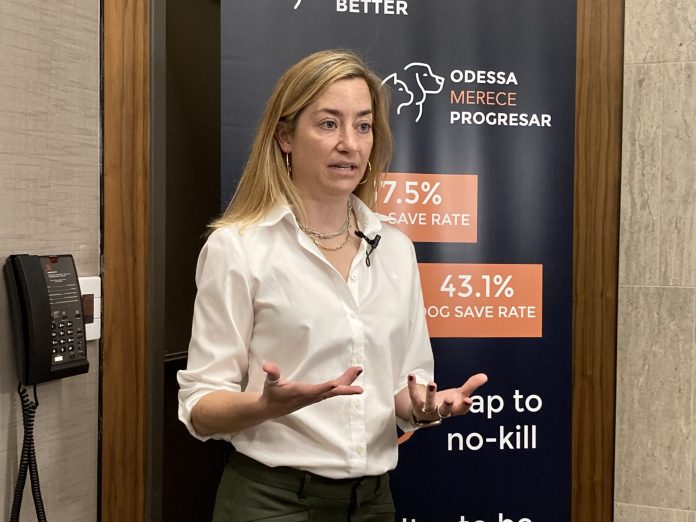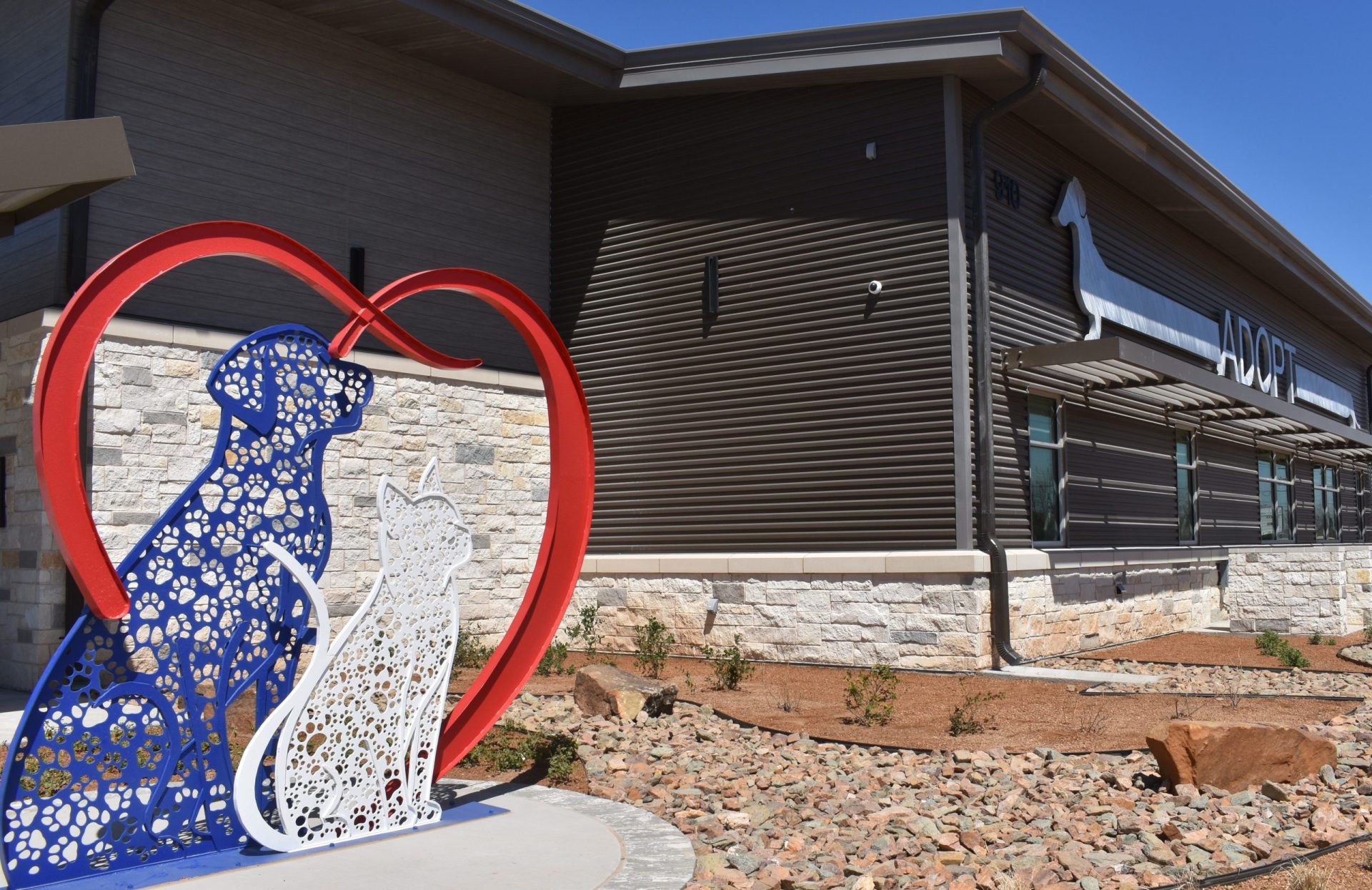
With a save rate of just 38 percent, Best Friends Animal Society, a national animal welfare organization, held a news conference at the Odessa Marriott Hotel & Conference Center Monday to offer support to Odessa Animal Services to increase the save rate at the local shelter and spark community involvement.
In 2023, 62 percent of dogs and cats that entered Odessa Animal Services were killed, according to information from the organization.
The save rate at Odessa Animal Services was 38 percent, a recent community survey showed that 71 percent of Odessa residents believe their local shelters should strive for no-kill status, the information detailed.
The city did not respond to a request for comment.
“Saving dogs and cats in shelters is the responsibility of everyone in the community. The commitment to increase lifesaving begins with the shelter, but is incumbent on the City of Odessa to support Odessa Animal Services, the shelter’s staff and the communities they serve,” according to Best Friends.
Sophia Proler, director for the South Central Region of Best Friends Animal Society, explained what Best Friends is and what it does.
“We work alongside municipalities around the country to make communities safer for people and pets. We’re the only national organization that collects and analyzes individual animal shelter intake and outcome data and makes it publicly available to increase transparency,” Proler said.
“We then use that data for financial and programmatic decisions to make sure that we cater our work to the community’s particular needs. Since 1984, Best Friends has helped reduce the number of animals killed in shelters from an estimated 17 million per year to around 380,000 per year in 2023.
“We’ve made a lot of progress, but we’re not quite there yet. So why we’re here? The current national save rate, a benchmark that measures the number of cats and dogs entering your shelter system and leave alive, is 83%. Our goal as Best Friends Animal Society is to help communities reach 90%, where no healthy treatable adoptable animal is killed just due to lack of space or time or resources. In 2023, the state of Texas has a save rate of 77% lagging a little bit behind that national average,” Proler said.
According to the data she shared Monday, Proler said Odessa Animal Services is the fourth-highest killing shelter in Texas with a save rate of only 37.5%.
“That means 2,655 healthy or treatable pets are killed each year in the care of Odessa Animal Services. That’s tough to hear. That’s also why we’re here and we’re committed to change. So let’s dig in a little bit more. That number that I mentioned before, that 37.5% save rate. What that comes out to is that 5,060 dogs and cats entered the care of Odessa Animal Services in 2023 and only 1,899 left alive. Think about it in a different way. For cats alone. Less than one in three cats left Odessa Animal Services alive last year. Similar-sized cities like McAllen, Texas, down in the Valley are saving nearly nine out of 10 animals coming into their shelter. Abilene, just up the road, is saving eight out of 10 animals that come into their shelter. So we know that it is possible to make improvements. We know we can save more animals,” Proler said.
Caitlin Sands, director of grassroots advocacy for Best Friends, said they are launching a campaign Monday called Odessa Deserves Better to engage the community and build a groundswell of support for change at Odessa Animal Services.
“We know from talking to the community and hearing from them, that they really want to see change, that they want to see a focus on saving dogs and cats. We conducted a poll in March of 2024 with registered voters in Odessa to ask them what they thought. Seventy-one (71) percent of those surveyed indicated support for Odessa striving to achieve no-kill status.
“No-kill status is where at least 90% of the dogs and cats that enter shelter ultimately leave alive. Seventy-eight (78) percent of those surveyed want elected city leadership to work with sheltering experts to reduce the number of outdoor cats, specifically that are being killed,” Sands said.
Best Friends also polled people to ask, in general, what they thought about euthanasia.
Seventy-one (71) percent of those surveyed, believed that healthy and treatable animals should not be killed in the animal shelter.
Sands said this belief is in line with the no-kill philosophy. The public also prefers trap, neuter, vaccinate, return, known as TNVR, to impounding and killing outdoor stray cats by a margin of over 6 to 1. Eight out of 10 people surveyed agreed that it should be a goal of Odessa Animal Services to adopt policies to decrease the number of dogs and cats killed. They also agreed that local government leaders should accept free, outside help and expertise to make lifesaving a priority.
“What we found again and again throughout the poll, was that the people of Odessa want to see dogs and cats saved and they do not want killing to be (the) first option,” Sands said.

She said local and national groups have offered the city financial and personal training, comprehensive cat programming, veterinary services, and veterinarian advised medical triage and protocols.
“At this point they are being turned down. So what needs to be done to create the change that we want to see here in Odessa? We really need the City of Odessa to accept support, and honestly make that commitment to prioritize animal lifesaving in the shelter. We know that it’s going to take a collaboration and that we all need to be involved. The community here wants to see that commitment and they want to see dogs and cats saved,” Sands said.
“Comprehensive cat programming needs to be implemented to address the unnecessary cat and kitten deaths that are happening. The city needs to make that commitment to fiscally responsible spending of their taxpayer dollars for animal services. The taxpayers in Odessa want to see their money being used to save those lives and not to kill them. We know that lifesaving is important to the dogs and cats that are depending on Odessa Animal Services and to the residents of Odessa. Lifesaving ultimately is a result of a collaborative effort and national and local groups, including us, are ready and waiting to support Odessa Animal Services, its staff and the community. We know that it’s possible here and we’re all ready to pitch in and create that change,” Sands said.
Proler said there are a number of different ways you can work to save more cat lives in your community and in your shelter.
“That can include anything from what we mentioned trap, neuter, vaccinate, return where you take an outdoor cat, get it spayed, neutered and seen by a vet and then released back to its home outside. There’s also kitten foster programs where you take orphaned, underage or vulnerable kittens and place them into foster homes until they’re healthy enough to be adopted. And also forward-thinking, sheltering policies to adopt more of those cats and kittens out into” the community, she added.
Proler said Best Friends has offered variations of help to the city from financial to shelter assessments to veterinary services and the answer has continued to be “not right now.”
She noted that animal shelters are meant to be a safe haven and a last resort for someone who can’t care for their pet anymore or is moving and the pet policies in the new place are unable to accommodate the pet.
“What we focus on is once an animal is in that shelter system, finding every possible opportunity to let it leave alive, whether that’s returning home,” it got lost, or finding someone who was looking for that pet to enter their lives, Proler said.
Some of it is about matchmaking with humans and pets.
“That’s a big piece of what we do as well when we go into shelters and partner with them to build strong adoption policies so that they can work alongside the community and not be at odds with the community,” Proler said.
She added that there are wonderful local groups who rescue dogs and if Animal Services would partner with them and national groups who can provide funding, mentorship and guidance, far fewer animals would be killed each year.
Coming from a municipal background, Proler said she knows change doesn’t happen overnight and Best Friends is willing to work with anyone as long as the goal is to save more animals.
“Even if Odessa Animal Services is maybe not committed to the exact number that might qualify as no-kill, that doesn’t mean that we can’t save more animals together. It doesn’t mean offer help, so long as they continue to contribute to lifesaving progress. So I think that’s a big piece of it. A lot of folks see it as black and white. But for us, there’s a spectrum of services that we provide so long as we are both sitting at the table looking to save more animals and in particular, there’s a very real desire from Odessa citizens as we saw survey to implement trap, neuter, vaccinate and return. That’s something that we can absolutely work with Odessa Animal Services (on). We’ve done this in many different communities all across Texas. I have a team of 12 down in Houston and then another four all around Texas to do this kind of work. We would love to do and it’s a lot of fun to see the relationship grow and improve between animal services in the community, when instead of catching someone’s cat and killing it, you fix it and return it back home,” Proler said.
She added that Best Friends is on hand as a servant to the community. They have heard that the community wants more animals leaving their shelter alive.
“We can make recommendations and we can connect the dots between different community members, different community services, so that people feel more empowered to help Odessa Animal Services save more animals if they are willing to do so. As we mentioned before, so many folks in this community are already doing that work. They’re rescuing a stray dog that maybe got injured or they find an orphan kitten and they’re raising it themselves. They understand that if they take it to the shelter, it’s going to be killed,” Proler said.
She added that if they can mend some of the relationship between the community and what the community wants and marry it with what Odessa Animal Services can provide, that’s a success because it will save more animals.
Steve Ford, a board member of the Odessa Humane Society who attended the news conference, said he wishes the city would take the opportunity to let Best Friends help them. He said he and his wife have been to the Best Friends facility in Utah and helped out there for a few days.
“I know they’re a quality organization that is really in it for the animals,” Ford said.



